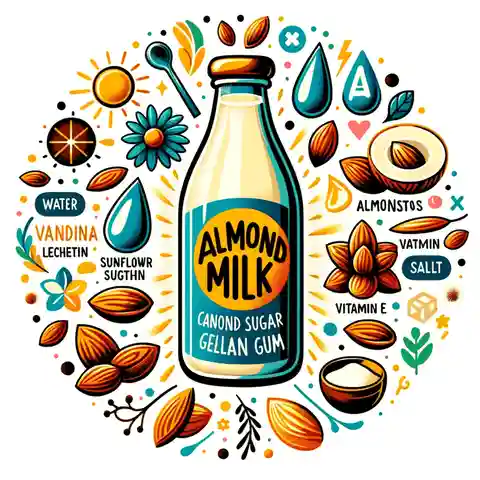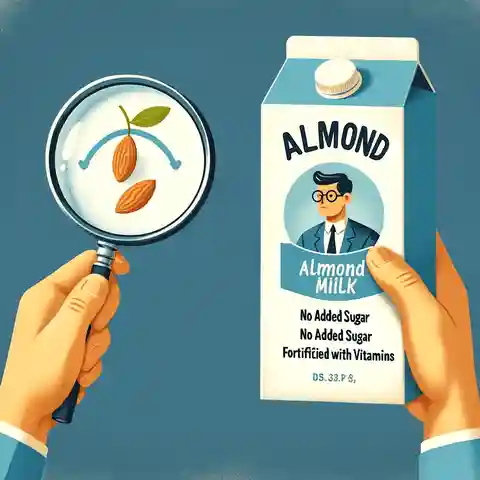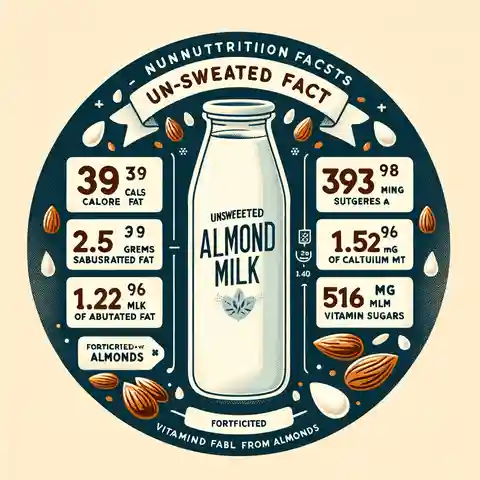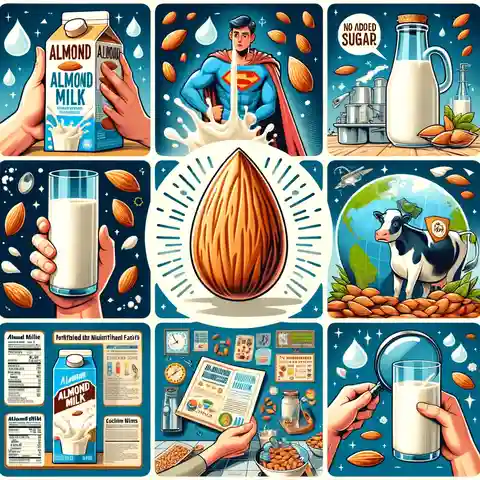Almond milk food label! Almond milk is a tasty drink made from water and almonds. It’s an excellent choice for folks who don’t drink cow’s milk.
It also tells you if they added more good things like calcium and vitamin D, essential for strong bones. And It is crucial if you want to eat healthily, have to follow a special diet, or just want to know more about what you’re drinking.
The label helps you pick the best almond milk, like one with less sugar or more vitamins. Let’s dive into what’s on the Almond milk food labels and why it matters.
What is almond milk nutrition facts?

Almond milk is a popular alternative to cow’s milk, and it’s known for being low in calories and fat while also providing some essential nutrients.
Here’s a overview of the nutrition facts for a typical serving of unsweetened almond milk (about 1 cup or 240 ml):
- Calories: Approximately 39 calories
- Protein: About 1.55 grams
- Fat: Roughly 2.88 grams, with a low amount of saturated fat (0.21 grams)
- Carbohydrates: Around 1.52 grams
- Fiber: Essentially none
- Sugars: Very minimal or none, especially in unsweetened varieties
- Almond Milk Calcium: Often fortified to have around 516 mg, which is about 50% of the daily value
- Vitamin D: Also commonly fortified in almond milk
- Vitamin E: Naturally present due to almonds being a good source
The nutritional content can vary between brands, especially between sweetened and unsweetened varieties. Sweetened almond milk will have added sugars and potentially higher calorie content.
What are the list of ingredients in almond milk?

The ingredients in almond milk typically include a blend of water and almonds as the base. Here’s a general list of ingredients you might find in almond milk:
- Water: The primary ingredient, used to blend with almonds to create the milk.
- Almonds: Ground almonds are the main flavor and nutrient source.
- Sweeteners: In sweetened almond milk, cane sugar or other sweeteners are added for taste.
- Emulsifiers and Stabilizers: Ingredients like lecithin (often from sunflower) and gellan gum are added to prevent separation and improve texture.
- Fortifying Vitamins and Minerals: Many brands add calcium, vitamin D, vitamin E, and vitamin A to enhance nutritional value.
- Flavorings: Vanilla or chocolate flavors may be added to flavored varieties of almond milk.
- Salt: A small amount of salt can be added to enhance the overall flavor.
Making and Keeping It Fresh

Making and keeping almond milk fresh involves a simple yet careful process. Here’s how you can do it and ensure it stays nutritious and tasty:
Making Almond Milk
Soak Almonds:
- First, put almonds in water and let them sit all night or even for two days. The more you soak them, the creamier your milk will get.
Blend Almonds:
- Next, get rid of the soaking water and blend the almonds with new water. Usually, you mix 1 cup of almonds with 2 cups of water. You can change this to make your milk thicker or thinner.
Strain It:
- Then, use a special bag for nut milk or a strainer to take out the bits of almond. You’ll get smooth milk.
Add Tastes (If You Want):
- If you like, you can make it sweet or add flavors like vanilla. Do this after you strain it.
How to Keep It:
- Put your almond milk in a clean bottle that doesn’t let air in. Bottles made of glass are the best for keeping it fresh.
- Always keep it in the fridge. Since homemade almond milk doesn’t have stuff in it to keep it from going bad, it needs to stay cold.
- Use it up quick! If you made it at home, drink it in 4-5 days. Store-bought almond milk lasts a little longer, but once you open it, try to use it soon. Check the box to see how long it’s good for.
- If it smells funny, tastes weird, or looks odd, don’t drink it. It might be bad.
Nutritional Freshness
- Drink it soon after you make it. This way, it keeps more of the good stuff like vitamins.
- Keep it away from the fridge door. It’s warmer there, and the heat can make the almond milk not as fresh.
These tips, you can ensure your almond milk is delicious and nutritious from the first sip to the last. Enjoy your fresh, homemade almond milk in smoothies, cereals, or just by the glassful!
Is almond milk considered dairy or protein?
Almond milk is not dairy; it’s a plant-based drink made from almonds and water. People choose it as a dairy-free option. It’s different from milk from cows because it doesn’t come from animals.
Almond milk has some protein, but not as much as cow’s milk or soy milk. It’s good to know that almond milk is often added with vitamins and minerals to make it even better for you.
Does almond milk have any health warnings?
Sometimes, people worry about certain things in almond milk. For example, some almond milk has an ingredient called carrageenan, which a few folks think might upset their stomachs.
But, many almond milk brands now say “no carrageenan” right on the label, so you can choose those if you want.
Almond Milk Food Label Eco-Friendly?
Almond milk is a cool choice for the planet compared to cow’s milk. Here’s why:
Lower Carbon Footprint
- Less Pollution: Making almond milk doesn’t create as much air pollution as making cow’s milk. So, it’s nicer to our air.
- Needs Less Space: Almond trees don’t need as much room to grow as cows.
Water Stuff
- Thirsty Trees: Almond trees love water and need a lot, especially in sunny California, where almonds are grown.
- Better Than Some: Even though almond milk needs more water than drinks like oat or soy milk, it still uses less water than cow’s milk.
Sustainability Efforts
- Saving Water: Farmers are finding new ways to give almond trees enough water without wasting it.
- Earth-Friendly Farming: Some almond farms use solar power to ensure bees are happy and healthy.
Choosing Smart
- Look for Good Brands: Some almond milk makers tell you how they help the planet. Try to pick those when you can.
- Try Different Milks: Many plant milks are out there, like oat, soy, and rice milk.
- Balance is Key: If you like almond milk, that’s great! Just remember to try other plant milks, too.
Even though almond milk is better for the Earth in some ways, we still have to think about how much water it needs. But if we make smart choices, we can enjoy almond milk and help the planet, too!
Silk Almond Milk

Silk Almond Milk is made with simple stuff that’s good for you. Here’s what’s in it:
- Water and Almonds: These are the main things that make it almond milk. They blend water with almonds to create the milk.
- Vitamins and Minerals: They add some healthy extras like calcium (for strong bones), vitamin E (keeps your skin healthy), vitamin A (good for your eyes), and vitamin D2 (also for strong bones).
- A Little Bit of Oil: Sometimes they use sunflower, almond, or canola oil to make the milk smooth.
- Sea Salt: Just a pinch to make the taste just right.
- Gellan Gum: This is a natural thing that helps keep the almond milk thick and not watery.
- Vitamin C (Ascorbic Acid): They add this to keep the milk fresh longer.
- Natural Flavor: This makes the milk taste even better without adding anything fake.
Silk Unsweetened Almond Milk

It doesn’t have any sugar added and gives you more calcium than regular milk. That’s great for making your bones strong! You can enjoy it with your breakfast cereal or just drink it on its own.
This almond milk is totally vegan and doesn’t have dairy, GMOs, gluten, carrageenan, cholesterol, or any fake colors or flavors. Each cup has only 30 calories, a little bit of fat but no bad fat, no sugar, and some protein.
Silk cares a lot about our Earth. Making their almond milk uses way less water and makes less air pollution than making cow’s milk. They also make sure to use water wisely, giving back to nature.
Bottom Line
Almond milk is a yummy, dairy-free option that’s good for you and the planet. Just remember to check the almond milk food label for sugar content and added nutrients to pick the best one for you. Enjoy your almond milk adventure!
For more detailed information, you can visit Silk’s official site and learn more about their range of almond milk beverages and their benefits.
Unsweetened Almond Milk: https://silk.com/plant-based-products/almondmilk/unsweet-almondmilk/
Almond milk Beverages page: https://silk.com/plant-based-products/beverages/almondmilk/



